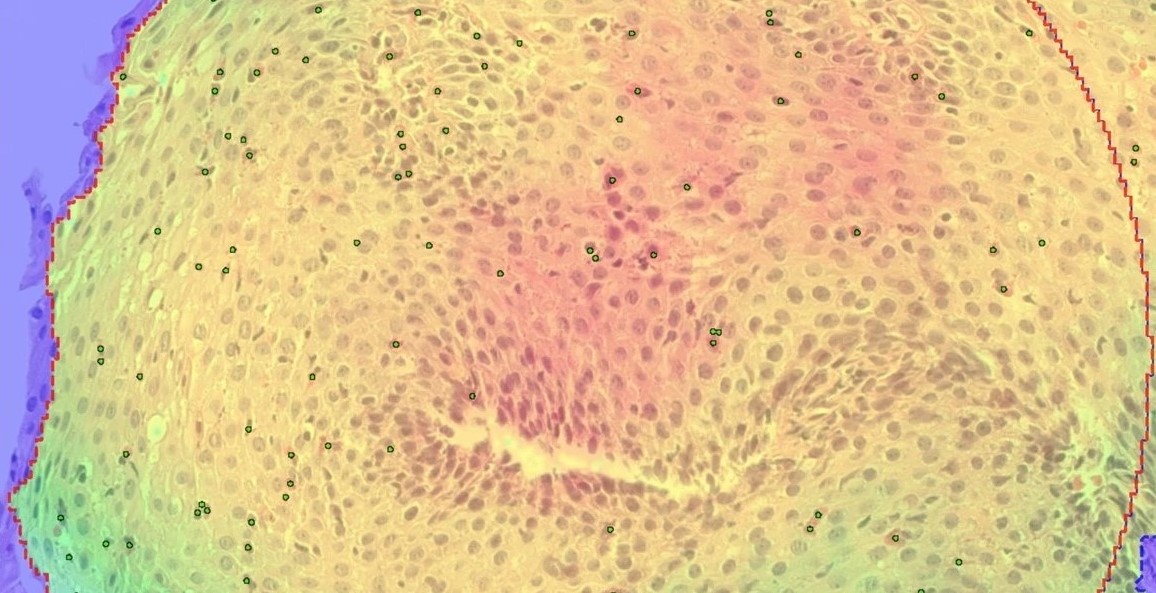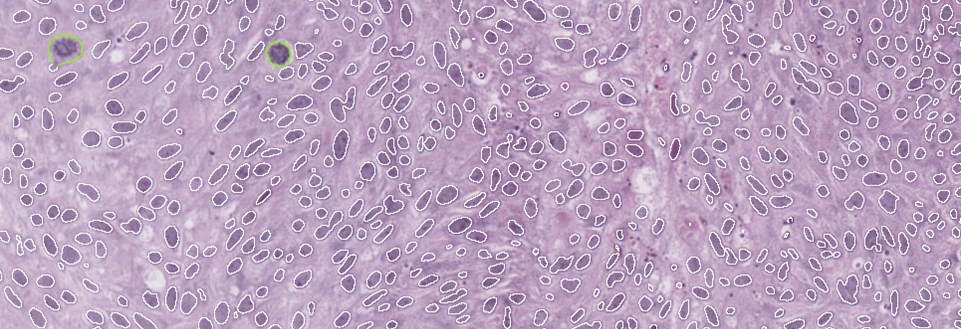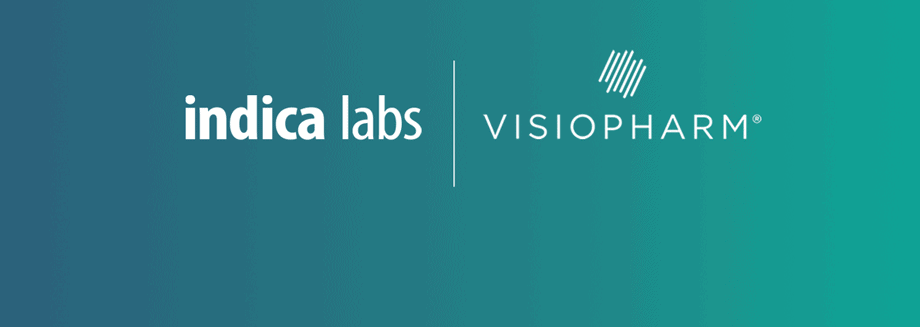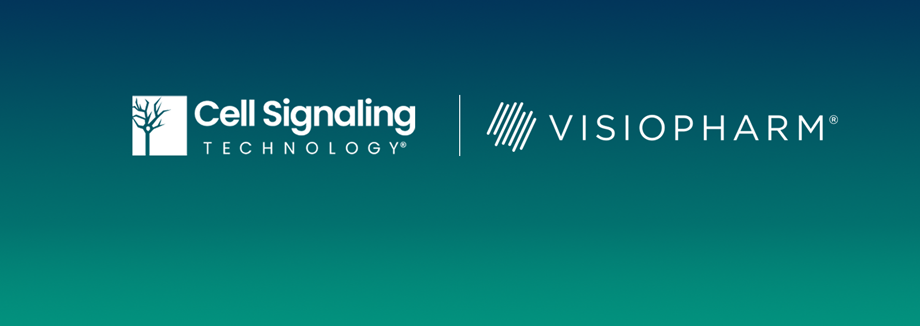Alimentiv is at the forefront of delivering digital pathology solutions through its combination of a state-of-the-art specialty histology laboratory, AcelaBio, and digital image analysis services, powered by Visiopharm® software. This end-to-end offering of high-quality sample processing and quantitative biomarker analysis provides our clients with robust insights into histopathology, drug mechanisms of action, target engagement, and pharmacodynamics.
In this recent interview, Alimentiv’s Lead Scientist, Pavine Lefevre PhD, shared her insights on Alimentiv’s histopathology services and the advantages of the Visiopharm® platform.
Dr. Pavine Lefevre is a distinguished scientist specializing in precision medicine and digital pathology. She currently serves as the Lead Scientist at Alimentiv, a contract research organization focused on gastrointestinal diseases. With over 10 years of experience collaborating with clinicians, scientists, and pharmaceutical organizations, Dr. Lefevre oversees translational research exploring histopathology, drug mechanisms of action, pharmacodynamics, and pharmacokinetics. She utilizes cutting-edge technologies in molecular and cellular biology, customizing approaches based on client needs to ensure the success of clinical trials and ultimately improve human health.

Visiopharm: Can you tell us about Alimentiv, your services, and how you differentiate yourself from other CROs?
Dr. Pavine Lefevre: Alimentiv is a specialized CRO driving innovation in clinical trials for inflammatory bowel disease (IBD) and other GI conditions, such as celiac disease and eosinophilic esophagitis. We provide comprehensive support for drug development, guided by leading gastroenterologists and scientists. Alimentiv delivers exceptional medical imaging expertise, supporting endoscopic and histopathological scoring for critical clinical trial data. In combination with our specialty CAP/CLIA-certified laboratory, AcelaBio, we offer seamless end-to-end workflows for GI tissue biopsy analysis. This includes spatial transcriptomics, multiplex immunofluorescence, digital pathology, and advanced image analysis. We not only support exploratory endpoints in clinical trials but also drive internal research to deepen our understanding of IBD histopathology, ultimately accelerating drug development and improving patient outcomes.
Visiopharm: What problems were you trying to solve when you started working with us compared with previous analysis software, and how did Visiopharm help you overcome those challenges?
Dr. Pavine Lefevre: Initially, we relied on external vendors for digital image analysis, a valuable step in our early development. However, to enhance our capabilities and streamline our workflow, particularly after establishing AcelaBio as our in-house histopathology laboratory offering advanced staining techniques like multiplex IHC/IF, we decided to bring digital image analysis in-house. Quantitative image analysis, under pathologist oversight, was crucial for achieving precise measurements and tackling complex research questions.
We chose Visiopharm for its comprehensive software that perfectly aligned with our business needs, complemented by their exceptional customer support and training. This strategic move empowered our precision medicine team to deliver more in-depth tissue characterization and advance our understanding of disease mechanisms.
Visiopharm: What specific features of our software do you find most helpful?
Dr. Pavine Lefevre: Visiopharm’s Author module allows us to develop highly customized, high-performance algorithms (“APPs”) by offering exceptional flexibility in parameter and setting selection. The introduction of the AI Author module, featuring deep learning-based classification, has changed our analysis capabilities, delivering robust and precise results.
We’ve achieved significant success using the TissuealignTM, TissuearrayTM, and PhenoplexTM modules in combination with the AI Author, finding these tools to be great to work with.
Visiopharm: Can you share a specific case study where Visiopharm’s software helped you solve a particularly challenging problem in your research or analysis?
Dr. Pavine Lefevre: Last year at Digestive Disease Week (DDW), we presented our digital pathology analysis algorithm designed to automate peak eosinophil count (PEC) quantification in eosinophilic esophagitis biopsies (Figure 1). This project aimed to create a computer-aided tool to assist pathologists in accurately quantifying PEC from whole slide images of H&E-stained esophageal biopsies in clinical trials. We collaborated with Drs. Evan Dellon (UNC) and Arjan Bredenoord (Amsterdam UMC), who provided esophageal biopsy images for algorithm training and development. The images were manually annotated by pathologists and used to train and develop an eosinophil counting APP with Visiopharm.
The algorithm was developed and iteratively refined, through validation, to accurately: detect the tissue area, detect and count eosinophils across the entire tissue section, and precisely identify and count eosinophils within a 40x high-powered field hotspot, representing areas of peak eosinophil density. Validation via Sensitivity Assessment of the APP demonstrated a strong correlation between the APP’s automated PEC and pathologist manual counts (Spearman r = 0.9895). We aim to use this APP to facilitate augmented reading in the near future.

Visiopharm: Could you share some insights into how the software has added value to your business and your customers?
Dr. Pavine Lefevre: Acquiring Visiopharm software has enabled us to expand our business capabilities, allowing us to offer a seamless, end-to-end digital pathology solution from biopsy processing to sophisticated image analysis.
By leveraging Visiopharm, we achieve rapid, quantitative biomarker analysis with enhanced precision and efficiency. This translates to richer, more comprehensive insights into critical aspects of histopathology, drug target engagement, and pharmacodynamics.
Visit Alimentiv’s website to learn how our precision medicine services can advance your research. Discover our comprehensive services, advanced technology, and proven expertise.
Learn more about Visiopharm software here.
About Alimentiv, Inc.
Alimentiv is a leading specialty GI-focused CRO, advancing frontiers of gastrointestinal (GI) clinical trials and medical research since 1986. As a global CRO offering clinical, medical imaging and precision medicine services, Alimentiv partners with pharmaceutical and biotechnology industries to advance the development of novel therapies and accelerate their time to market. Alimentiv is headquartered in London, Ontario, Canada, with a global footprint across its operations in Canada, the United States, Europe, Asia-Pacific, and Latin America. For more information, visit www.alimentiv.com.
About Visiopharm
Visiopharm is a leading provider of AI-driven precision pathology software for research and diagnostics. In research, it is a technology leader providing tools that help scientists, pathologists, and image analysis experts produce accurate data for all types of tissue-based research. In diagnostics, it is a leader within clinical applications, with no fewer than nine diagnostic algorithms cleared under IVDR for EU and UK customers. These applications provide diagnostic decision support and can be easily activated and integrated into existing lab workflows. Founded in 2002, Visiopharm is privately owned and operates internationally with over 750 customer accounts in more than 40 countries. The company’s headquarters are located in Denmark’s Medicon Valley, with legal entities in Sweden, the UK, Germany, the Netherlands, and the United States, and local representation in France and China.
 Visiopharm
Categories: Blog Tags: digital pathology, image analysis software
26320
Improving bladder cancer grading with AI-driven image analysis: A conversation with Prof. David Berman
Visiopharm
Categories: Blog Tags: digital pathology, image analysis software
26320
Improving bladder cancer grading with AI-driven image analysis: A conversation with Prof. David Berman
As part of our Discovery Stories: People Behind Discovery series, we had the privilege of speaking with Professor David Berman, a leading researcher focused on developing high-impact cancer tests for prostate and bladder cancer patients. In this interview, Prof. Berman shares insights into his team’s efforts to improve bladder cancer grading. By using Visiopharm’s AI-driven software, they are automating the analysis of millions of nuclei, creating more accurate and objective grading systems, and tuning them to better predict patient outcomes. He also discusses how these advancements will advance the field of pathology and enhance clinical decision-making.

Dr. David M. Berman (Principal Investigator and Professor at Queen’s University in Kingston, Ontario) leads a research group developing high-impact cancer tests for prostate and bladder cancer. The team identifies novel biomarkers and therapeutic targets to improve patient outcomes by integrating data from genomic databases, experimental studies, and curated human biospecimens. This approach yields personalized management strategies tailored to each patient.
Read on or watch the video to learn how Visiopharm’s tools empower Prof. Berman and his team to push the boundaries of cancer research and diagnostics.
Visiopharm: What is the primary focus of your research?
Prof. David Berman: Our project focuses on turning bladder cancer grading into an objective algorithm. Pathologists today categorize early bladder cancer into low-grade and high-grade; however, there’s a great deal of variability among pathologists in how grading is performed. If a patient has low-grade cancer, they are typically managed with infrequent and limited surveillance. This surveillance involves inserting a camera through the urethra to examine the bladder for new tumors. While this procedure is necessary, it is uncomfortable, expensive, and inconvenient for patients. Additionally, it places a significant financial burden on health systems, making bladder cancer one of the most expensive cancers to manage.
In contrast, if a cancer is high-grade, the patient is offered more frequent surveillance and intensive immunotherapy, which is administered directly into the bladder. The difference between low-grade and high-grade is illustrated in the image below:

Low-grade tumors have relatively uniform-looking nuclei. Most of these nuclei are oval, and they are similar in size and shape. Most of them are also oriented in such a way that it appears as though you’ve combed the nuclei from the bottom of the screen toward the top. This creates a well-organized tissue. The cells respect each other’s space and align well with each other, much like they would in the benign tissue from which this cancer arises, known as the urothelium.
On the other hand, in high-grade cancer, the nuclei are not uniformly oval. They appear to be oriented in various directions, and you’ll notice that some are significantly larger than others. Some of the cells are undergoing mitosis, indicating rapid proliferation> These look like eyelashes or spider webs.
Like many studies before us, we found that even the best possible agreement among expert pathologists—like me, having specialized in urologic pathology for over 20 years—is about 80%. We had experts from three different academic centers review our cases, and we discovered that the same cancer could be treated differently depending on the pathologist about a third of the time. This unacceptably high level of variability is the best we can achieve because it largely comes down to judgment. There are many complex features involved in describing the size, shape, and orientation of cells in bladder cancer, which determine whether it’s low-grade or high-grade. But these features don’t involve precise measurements or numerical values.
For example, low-grade tumors may have occasional mitoses, while mitoses are more frequent in high-grade tumors. However, terms like “occasional” and “frequent” are subjective, and it’s unclear where to draw the line.
This is the issue we aimed to address in our study, which we published in collaboration with Regan Baird and Dan Winkowski from Visiopharm 1.
The study, led by Ava Slotman, who was then a graduate student in the lab, is the largest study of nuclear measurements as part of cancer grading. We measured over three million nuclei from 371 cases, including 641 images. Using Visiopharm, we measured every cancer nucleus in every case. This included an automated APP that we trained to distinguish cancer tissue from benign tissue. This process resulted in an enormous data set that we could analyze using complex algorithms to examine the differences between low-grade and high-grade tumors. Visiopharm provided us with a wide range of relevant features to explore in our analysis.

individual nuclei (white lines), mitotic figures (green lines) and tissue regions (blue dashes outline tumour,
grey dashes non-tumour). A. Histology representative of low-grade. B. Histology representative of high-grade.
We found that the most informative single variables distinguishing low-grade from high-grade tumors were variation in nuclear size, specifically the area, and the mitotic counts. Each of these factors was about 80% accurate in distinguishing between the two grades. From there, we developed more sophisticated algorithms that increased accuracy, such as random forest, decision trees, and logistic regression.
We believe that we have redefined and simplified grading by focusing on measurable features. In fact, we were able to externally validate one of these algorithms, the random forest, in another cohort. By using these features, we can actually improve grading so that it does a much better job of separating patients whose cancers recur quickly from those that recur slowly or not at all. This is part of our unpublished work with Katherine Lindale, which shows that we can create prognostic scores by reprioritizing the features.

We use these curves to show the time to recurrence—essentially, how long it takes for a second cancer to develop after the initial tumor is removed. In Figure 3A, you see the results using regular pathologist grading for the entire case. There’s a slight difference between low-grade and high-grade tumors, but the clouds overlap, meaning the distinction isn’t very dramatic. While the difference is statistically significant, it’s not very pronounced.
In Figure 3B, you can see the results from our reprioritized grading algorithm using numerical cutoffs. This approach provides a much lower p-value and creates a greater separation between the curves. The bottom curve, representing low-grade tumors, recurs much faster than the top curve, which represents high-grade tumors that recur far more slowly.
This improved grading technique could significantly guide treatment decisions. Patients with low prognostic scores could be treated with less frequent surveillance and cystoscopy, and might not need immunotherapy. In contrast, higher-risk patients would receive the intensive surveillance and treatment they require.
That summarizes what we’ve done with Visiopharm and where we are now. Most of this work was done with small image samples, but we are now working together on an algorithm for whole-slide images, and progress is going well.
Visiopharm: What challenges or limitations in your research led you to consider using AI solutions like the Visiopharm software?
Prof. David Berman: Previous studies often relied on manual measurements of each nucleus, which would limit us to maybe a hundred nuclei per case instead of thousands. With manual methods, we might be able to measure a thousand nuclei, but very slowly, compared to the millions of nuclei we can measure using higher-throughput techniques. This increased throughput enables us to perform much more sophisticated analyses. Additionally, with the number of features involved, I don’t think we could have manually assessed and measured every single one of those features that I showed you in our study.
Visiopharm: In what ways did Visiopharm prove to be the only viable solution for your research needs compared to other tools or methods you’re considering?
Prof. David Berman: When we were choosing image analysis software, we found that Visiopharm offered a much richer dataset compared to other tools we were considering. It had many more features already built into it, and it was much easier to sequence different feature detectors one after the other in a pipeline.
Pricing also played a role in our decision. Some other commercial vendors would charge for each type of analyzer or software, while Visiopharm provided us with access to the entire package, which was a significant advantage.
Another key reason for choosing Visiopharm was their fantastic customer support. They truly felt like collaborators, and that level of partnership was incredibly important to us. It made the project go much more smoothly and continues to do so today.
Finally, we wanted to work with a group that could help us eventually bring this classifier to a clinical desktop. We knew Visiopharm had the connections and capability to make that happen.
“We didn’t want this work to remain solely in the research environment. We’re working toward getting it into clinical operation because we believe this approach can significantly improve patient management.“
Visiopharm: What are the next steps for moving from research to clinical application?
Prof. David Berman: The major step we’re working on now is moving from small image samples, which are about a millimeter in diameter, to whole-slide images. Pathologists diagnose bladder cancer—and other cancers—from whole slides, not from small image samples. Transitioning to whole slides will give us more power to analyze heterogeneity in these features and explore whether there is a specific proportion of the cancer that must be high-grade to drive a poor prognosis. This is something that other investigators have done qualitatively, but we see a huge opportunity to do it quantitatively using these tools. Additionally, validation with external cohorts is always necessary, and we are collaborating with several partners to make that happen.
Another important point is that much of AI use in pathology treats AI as a black box, where the image analysis program simply matches an image to a previous set of images and tries to emulate expert opinion. However, by focusing on “explainable” morphologic features that pathologists can see and verify themselves, we’re aiming for something more impactful. Our goal is not just to help pathologists who are struggling, but to elevate the work of all pathologists, even the best ones.
In regular practice, there’s no opportunity to match grading practices directly with actual patient outcomes. To do so, you would need to go back years later, review what happened to a patient, and then revisit the grading. This would require having proper measurements in place, and our research offers a new opportunity to achieve this kind of work in a much more accelerated way using AI and sophisticated computational technology.
Visiopharm: A lot of pathologists are still afraid of being replaced by AI, right?
Prof. David Berman: Yes, and I’ve heard even very sophisticated pathologists express that concern. But I wonder—do we really want to trust a program to make decisions on its own, without human expertise? For example, it could recommend very invasive and life-altering treatments like surgery to remove a major organ, chemotherapy, or immunotherapy, without any expert oversight. I don’t see that happening anytime soon.
“We don’t even have driverless planes yet, at least not with passengers. So, I don’t think AI will replace pathologists in that way anytime soon.“
Curious to see the work of Professor Berman? Check out these recent publications.
- Slotman A, Xu M, Lindale K, Hardy C, Winkowski D, Baird R, Chen L, Lal P, van der Kwast T, Jackson CL, Gooding RJ, Berman DM. Quantitative Nuclear Grading: An Objective, Artificial Intelligence-Facilitated Foundation for Grading Noninvasive Papillary Urothelial Carcinoma. Lab Invest. 2023 Jul;103(7):100155. doi: 10.1016/j.labinv.2023.100155. Epub 2023 Apr 13. PMID: 37059267.
 Visiopharm
Categories: Blog Tags: digital pathology, image analysis software
26460
Indica Labs and Visiopharm Deliver an Integrated Digital Pathology Image Management and Analysis Solution
Visiopharm
Categories: Blog Tags: digital pathology, image analysis software
26460
Indica Labs and Visiopharm Deliver an Integrated Digital Pathology Image Management and Analysis Solution
Albuquerque, NM and Hørsholm, Denmark — Indica Labs and Visiopharm today announce the successful integration of Visiopharm’s Discovery image analysis software into Indica’s collaborative image management platform, HALO Link. The integration will enable laboratories to create a customized digital pathology ecosystem optimized for their unique image analysis and collaboration needs.
“We are excited to deliver this combined solution to our customers in collaboration with Visiopharm,” said Steven Hashagen, CEO of Indica Labs. “The fully integrated solution allows for a more seamless user experience when working between Discovery and HALO Link, enhancing efficiency and freeing users to focus on their next discovery.”
“The integration with HALO Link reflects our firm commitment to remaining platform-agnostic across staining systems, scanners and image management systems,” said Michael Grunkin, CEO of Visiopharm. “Indica Labs has rapidly established itself as a key player in the IMS space, and we are very pleased to offer our joint customers a streamlined experience that brings together Indica’s collaborative platform with Visiopharm’s advanced AI-driven image analysis.”

The integration, available as a paid add-on with HALO Link 4.1, enables viewing of annotations, regions of interest (ROI), image markups, and analysis summary results generated in Discovery within HALO Link. HALO Link preserves the annotation layers and colors from Discovery, displays ROI and labels as interactive markups, streamlining viewing, and organizes analysis summary results in the image’s analysis tab. The integration functions with all image types supported by the platforms, as long as the image exists in both the HALO Link and Discovery databases.
HALO Link is a browser-based hub for pathology that helps research organizations worldwide safely and securely manage, share, and analyze digital slides and data. The platform offers seamless collaboration and limitless data organization with robust search capabilities. HALO Link natively integrates with HALO® and HALO AI, and its powerful API enables integration with LIS | LIMS systems, compatible third-party image analysis platforms, such as Discovery, and other third-party databases.
Visiopharm’s Discovery software enables users to explore complex tissue data intuitively and customize analyses to fit their specific experimental needs. Its advanced exploratory capabilities enhance analysis accuracy in complex tissue samples. The ability to develop custom deep-learning-based segmentation algorithms, which can account for both cellular and nuclear morphology, enables precise quantification of biomarkers.
The HALO Link 4.1 release is currently available. Contact support@indicalab.com to initiate a software upgrade.
About Indica Labs
Indica Labs is the global leader in AI-powered digital pathology software and services. Our flagship HALO® and HALO AI platform revolutionizes quantitative evaluation of whole slide images. HALO Link provides collaborative image management while HALO AP® and HALO AP Dx deliver enterprise digital pathology for primary diagnosis with regulatory clearances in multiple markets. Through a commitment to open pathology, performance, scalability, and ease-of-use, we help pharma companies, diagnostic labs, hospitals, research organizations, and Indica’s own Cloud and Pharma Services make discoveries and diagnoses that transform patient care and scientific discovery.
For more information, please visit https://indicalab.com or contact info@indicalab.com.
About Visiopharm
Visiopharm is a leading provider of AI-driven precision pathology software for research and diagnostics. In research, it is a technology leader providing tools that help scientists, pathologists, and image analysis experts produce accurate data for all types of tissue-based research. In diagnostics, it is a leader within clinical applications, with no fewer than nine diagnostic algorithms cleared under IVDR for EU and UK customers. These applications provide diagnostic decision support and can be easily activated and integrated into existing lab workflows. Founded in 2002, Visiopharm is privately owned and operates internationally with over 750 customer accounts in more than 40 countries. The company’s headquarters are located in Denmark’s Medicon Valley, with legal entities in Sweden, the UK, Germany, the Netherlands, and the United States, and local representation in France and China.
For more information visit visiopharm.com.
Indica Labs Media Contact:
Adam Smith
adam@indicalab.com
Visiopharm Media Contact:
Johanne Louise Brændgaard
jlb@visiopharm.com
Document ID: 16773_april 2025
 Visiopharm
Categories: Press Releases
26385
Cell Signaling Technology and Visiopharm Announce Partnership to Advance Spatial Biology Research
Visiopharm
Categories: Press Releases
26385
Cell Signaling Technology and Visiopharm Announce Partnership to Advance Spatial Biology Research
Streamlined multiplex immuno-profiling capabilities and AI-driven image analysis will be demonstrated during a poster presentation at AACR 2025.
Danvers, MA, USA — Cell Signaling Technology (CST), a life science discovery technology company and leading provider of antibodies, kits, and services, and Visiopharm, a global leader in AI-driven precision pathology software, today announced a strategic partnership to advance spatial biology research. The collaboration enables more streamlined analysis of images generated using the SignalStar® Multiplex IHC technology in Visiopharm’s Phenoplex software, helping researchers to more efficiently interrogate cellular interactions in the tumor microenvironment and streamline biomarker discovery and analysis.
“As multiplexed spatial biology assays become more flexible and robust, they must be paired with powerful, AI-driven image analysis solutions to truly uncover meaningful insights,” says Roberto (Roby) Polakiewicz, PhD, Chief Scientific Officer at CST. “We’re excited to partner with Visiopharm to provide researchers with a comprehensive toolbox of proven solutions so they can conduct advanced analyses of the tumor microenvironment with confidence.”
Through the partnership, CST and Visiopharm will deliver multiplexed biomarker staining, signal amplification, and data annotation and analysis capabilities, enabling spatial biology researchers to uncover actionable insights about disease progression and therapeutic response.
“At Visiopharm, we are committed to empowering researchers with AI-driven image analysis solutions that unlock the full potential of spatial biology,” said Regan Baird, PhD, Chief Research Solutions Officer at Visiopharm. “By combining CST’s cutting-edge multiplex IHC technology with our advanced Phenoplex software, we are enabling scientists to extract deeper, more precise insights into the tumor microenvironment. This partnership represents a significant step forward in accelerating biomarker discovery and advancing precision medicine.”
Visiopharm is a world leader in AI-based image analysis and workflow standardization, and CST offers best-in-class antibody technology for interrogating complex biological systems while maintaining their spatial context and tissue architecture. By combining the highly flexible antibody panels in the SignalStar Multiplex IHC assay with powerful AI-driven software from Visiopharm, biopharma researchers can confidently generate and analyze spatial data of the tumor microenvironment using a high-throughput method.
To demonstrate how CST and Visopharm’s capabilities in multiplex immuno-profiling can be leveraged together, the companies are presenting a poster at The American Association for Cancer Research (AACR) Annual Meeting 2025.
Poster:Spatial analysis of the DLBCL tumor microenvironment via the novel SignalStar® multiplex immunohistochemistry assay
Authors: Jennifer Ziello, Shuling Zhang, Sarah Klein, Derek Papalegis, Lily Vu, Gabriella Spang, Arvin Ruiz and Giorgio Inghirami
To learn more, visit CST at AACR 2025 at booth #809 or stop by poster number 24 in the Spatial Proteomics and Transcriptomics 1 poster session.
About Cell Signaling Technology
Cell Signaling Technology (CST) is a different kind of life science company—one founded, owned, and run by active research scientists, with the highest standards of product and service quality, technological innovation, and scientific rigor. Founded in 1999 and headquartered in Danvers, Massachusetts, USA, CST employs over 600 people worldwide. We consistently provide fellow scientists around the globe with best-in-class products and services to fuel their quests for discovery. CST is a company of caring people driven by a devotion to facilitating good science—a company committed to doing the right thing for our customers, our communities, and our planet. cellsignal.com
About Visiopharm
Visiopharm is a leading provider of AI-driven precision pathology software for research and diagnostics. In research, it is a technology leader providing tools that help scientists, pathologists, and image analysis experts produce accurate data for all types of tissue-based research. In diagnostics, it is a leader within clinical applications, with no fewer than nine diagnostic algorithms cleared under IVDR for EU and UK customers. These applications provide diagnostic decision support and can be easily activated and integrated into existing lab workflows. Founded in 2002, Visiopharm is privately owned and operates internationally with over 750 customer accounts in more than 40 countries. The company’s headquarters are located in Denmark’s Medicon Valley, with legal entities in Sweden, the UK, Germany, the Netherlands, and the United States, and local representation in France and China.
For more information visit visiopharm.com.
CST Media and Press
Rebecca J. Reppucci, MBA
Cell Signaling Technology, Inc.
Senior Director, Global Marketing Communications
Phone: +1-978-880-3334
Email: marketingpr@cellsignal.com
ID: 16755_03_2025
 Visiopharm
Categories: Press Releases
Visiopharm
Categories: Press Releases
